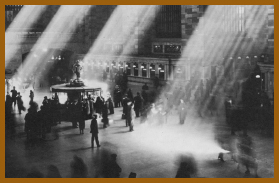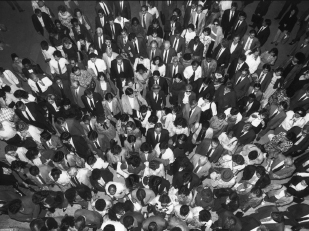

THROUGH THE OLD GRAND CENTRAL, 21 million passengers passed to and fro last year,” the Times gushed just before the new terminal opened in 1913. “Owing to the perfection of the new arrangement, five times as many, or more than the whole population of the United States, can be handled just as easily in 12 months.” Initially, the terminal was criticized as being too big for any traffic demand that could ever be made upon it. Now, a century later, Grand Central is finally nearing the 100 million passengers annually projected when it opened—instead of falling victim to its own success as what the Times’ Herbert Muschamp called “a flawed symbol of civic pride.” During the 1990s renovation, he wrote, the terminal seemed to be “in effect, a double agent,” because “while undeniably a great urban landmark, it is also a monument to the centrifugal forces—first trains, then cars, now modems—that since the 1920s have hastened the suburban exodus of the middle class.”
The flow was never one-way, though. Rather, it epitomized E.B. White’s “tidal restlessness,” which he believed defined metropolitan New York. If Grand Central began almost by accident—triggered by the fatal 1902 collision in the Park Avenue Tunnel—its rebirth has been the result of deliberate and enlightened leadership. It is no accident that the railroads served by the terminal did not suffer another fatal crash in more than 24 years. The graceful reincarnation of an inspired Gilded Age monument to private enterprise as a model of sound public investment has been no accident either.
HAD GRAND CENTRAL BEEN DEMOLISHED, the impact would have been humongous and global. “Hurting Grand Central inflicts millions of private pains as well as one big civic one,” the New Yorker wrote in 1975, when that threat was very real. “Suburban ladies who put on white gloves and a hat to meet at the Biltmore, commuters, children who go away to school—it is impossible for them not to realize that when they come to (or come back to) New York they are greeted not by any small or neutral experience but by a marvelously accessible grandeur, thoroughly democratic but vast enough to encompass the most outlandish aspiration.”
Instead of succumbing to the Penn Central’s desperately shortsighted survival strategy, the terminal was reconstituted in the original architects’ vision as a grand public space. If, as architect Robert A.M. Stern wrote, Reed & Stem and Warren & Wetmore created “a convincing expression of the belief that the goals of capitalism are not inimical to the enhancement of the public realm,” then the Metropolitan Transportation Authority has squared the circle in demonstrating that the public realm and capitalism can not only coexist, but thrive together.
“To educate and raise taste seems like an unimaginably difficult task,” Nathan P. Glazer of Harvard observed,
and yet it has happened. Consider the example of the preservation movement. Would it be possible to tear down Pennsylvania Station in New York today? Hardly. We have financial benefits for remodeling historic landmarks that we did not have in 1963, which has permitted the restoration and reuse of huge 19th- and 20th-century railroad stations; we have more effective means of legal intervention, as was demonstrated in the successful suit to prevent a tower from being placed on top of Grand Central Station; and supporting both we have a public that appreciates architecture more, even if it can be bamboozled and confused by publicity and false authority.
Even Frank Lloyd Wright, not a great fan of New York City, expressed a begrudging admiration for Grand Central. In the mid-1950s, Andy Rooney was a writer for a morning television show hosted by Will Rogers Jr. at the terminal’s CBS studios. Rooney was assigned to chaperone Wright, who was staying at the Plaza and was a guest on the show. “Wright grumbled about everything during the drive from the Plaza to the Vanderbilt Avenue side of Grand Central; he detested New York,” Rooney recalled.
There was access by elevator from the west side to our studio but I decided to force a tour on him. I took him down the marble steps off Vanderbilt and walked down kittycorner, past the clock, to the elevators in a little cubicle on the north side near the stairway that goes to the lower level. Those elevators went when they tore down the terminal buildings.
I recall clearly that he stopped and looked back across the grand room before we got on the elevator. The sun’s rays were slanting down toward the information booth from the windows above where the Kodak picture is now. “It is a grand building, isn’t it?” he said, almost apologetically, and I accepted this as a retraction for all the terrible things he’d been saying about everything else. We went to the third floor on the elevator and started across the catwalk. It’s one of the great sights in New York for me. Thousands of purposeful people going their own directions and with doors and stairs and levels enough for all of them in Grand Central.
Midway across, Wright stopped and neither of us said anything. He must have stood there for more than five minutes, and I didn’t speak because I knew nothing I had to say could match what he was thinking.
One measure of Grand Central’s success is the cachet the name now carries. In 1930, an imposing 53-story skyscraper across the street at 60 East 42nd Street was christened the Lincoln Building (after the Lincoln Storage Company and the Lincoln National Bank, which had occupied the site). In 2009, the owners, W&H Properties, moved the lobby’s bronze plaques, on which the Gettysburg Address and the Second Inaugural Address were immortalized, and evicted Daniel Chester French’s sculpture of the “seated Lincoln,” the model for the Lincoln Memorial in Washington, from the lobby. The building was renamed One Grand Central Place, confirming, said Fred C. Posniak, senior vice president of W&H, “the building’s reputation as the premier prewar trophy property within the Grand Central District, as well as its unsurpassed location directly across from Grand Central Terminal.” Just a decade earlier, any such association with Grand Central would have been considered toxic. Not anymore.
IN 1932, THOMAS WOLFE and his accommodating editor, Maxwell Perkins, boarded a train at Grand Central for Perkins’s weekend home in New Canaan, Connecticut. Trains figured prominently in Wolfe’s fiction, and in his life too. He and Perkins had been drinking a good deal that Thursday night (Wolfe “enjoys eating and drinking, and all of what is known of the good things in life,” Perkins later wrote).
For whatever reason, at the last minute Wolfe changed his weekend plans and precipitately jumped from the moving train. The six-foot-six author splayed onto the platform, breaking his arm and severing a vein. Eight years later, Wolfe’s You Can’t Go Home Again was published posthumously. His novel was about George Webber, a fledgling author, who tries to do just that—to go home again—this time from Penn Station, which, Wolfe wrote, was, like Grand Central, “murmurous with the immense and distant sound of time.”
Great, slant beams of moted light fell ponderously athwart the station’s floor, and the calm voice of time hovered along the walls and ceiling of that mighty room, distilled out of the voices and movements of the people who swarmed beneath. It had the murmur of a distant sea, the languorous lapse and flow of waters on a beach. It was elemental, detached, indifferent to the lives of men. They contributed to it as drops of rain contribute to a river that draws its flood and movement majestically from the great depths, out of purple hills at evening.
Few buildings are vast enough to hold the sound of time, and now it seemed to George that there was a superb fitness in the fact that the one which held it better than all others should be a railroad station. For here, as nowhere else on earth, men were brought together for a moment at the beginning or end of their innumerable journeys, here one saw their greetings and farewells, here, in a single instant, one got the entire picture of the human destiny. Men came and went, they passed and vanished, and all were moving through the moments of their lives to death, and all made small tickings in the sounds of time—but the voice of time remained aloof and unperturbed, a drowsy and eternal murmur below the immense and distant roof.
Wolfe’s evocation of Penn Station reverberates in the imaginary “silent bubble of space” that propelled Tony Hiss through Grand Central and in David Marshall’s “accidental music” of the Main Concourse. Referring to Penn Station and Grand Central, Lewis Mumford wrote that “the major quality of each station, one that too few buildings in the city today possess, is space—space generously even nobly handled.”
As for the Penn Station that Mumford rhapsodized, though, you can’t go there again. And, for all its glory, for all the nostalgia that Penn Station still generates and richly deserves, of the two mega-stations, arguably Grand Central transformed the nation’s norms and Manhattan’s cultural geography to a much greater extent. By serving as the underpinning for Park Avenue, the railroad provided a haven for New York’s super-rich, who, Mike Wallace, the coauthor of Gotham, observes, had been on the run for a century from Washington Square, Union Square, and even from their doubtful redoubts on Fifth Avenue. “The vast Park Avenue structures, dense with others of their own kind, provided a stability the rich had never known,” Wallace says. “And the establishment of the Upper East Side as a wealthy enclave helped to draw hotels, department stores and luxury shops uptown.” If Penn Station was a catchment for commuters from the east, Grand Central channeled commuting managers and professionals from the northern suburbs to Midtown (an incentive for corporate headquarters to roost there). The flow of commercial travelers and tourists transformed “a second-string business district to full-fledged rival of Wall Street” and generated demand for hotels and office buildings. “Finally,” Wallace argues, “the terminal itself was a powerful Midtown magnet, with its great soaring concourse, its barrel-vaulted Roman bath, its staircase as grand as the Paris Opera’s, its ceiling that was vaster than St. Peter’s nave, and in the opinion of some equally sublime. The romance of its 20th Century Limited service, the beauty and boldness of the enterprise itself—all were crucial factors in shifting the city’s cultural and commercial center of gravity to its doorstep.”
Grand Central, Paul Goldberger wrote, was never “as overpowering or as grandiose as the late Pennsylvania Station,” and its very integrality—the way “it wove its way into the fabric of New York City so subtly and so tightly that it couldn’t be ripped out”—may have been the overriding virtue that demanded it survive into a second century. Today, “the sound of time” still reverberates every day at Grand Central, which, more than any other place, embodies the voice of the city and the rhythms of urban America.
